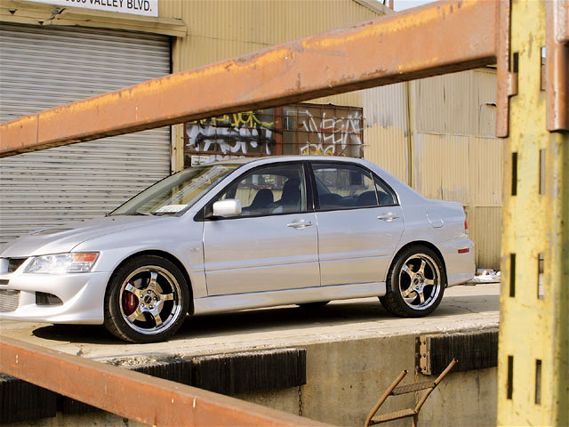 | Buddy Club Racing Spec Damper - Suspension Systems
| Buddy Club Racing Spec Damper - Suspension Systems
When you think about the performance of a vehicle; you more than likely compare stats for 0-60 mph, quarter-mile time and top speed. In order to generate stellar performance marks in these areas you need horsepower. Would you not agree that the more horsepower you could generate the faster the car can go? We hate to tell you this but horsepower is only half the equation to making a vehicle perform. A car's performance can only be as good as its suspension system. There is no point in generating 500 horsepower if the vehicle's suspension system was only designed to handle 200 horsepower
Think front-wheel drive here. Let's say there are two identical Honda Civics and both are equipped with the same suspension system but one vehicle makes 150 horsepower and the other makes 1,050 horsepower. If both Civics still utilized the factory stock suspension system with the 175mm wide stock tire the 150 horsepower Civic would more than likely "perform" better than the 1,050 horsepower one. The suspension system would be able to put the power to the ground more effectively with the low-output engine than with the high-output engine, which would instantly fry the tires once the throttle was smashed. Granted this is an extreme case, but you get the picture. It is not about how much horsepower you generate; it is however, about how much horsepower you can put to the ground without wasting any.
The main objective of a vehicle's suspension system is to absorb bumps and dips in the road and ensure the tires stay in contact with the pavement. The two main components in absorbing road imperfections are the shocks and springs. Coil springs found in the majority of vehicles manufactured today are the workhorses of the suspension, constantly expanding and compressing while the vehicle is in motion. The shock, also known as the damper, works in conjunction with the spring to control unwanted spring motion by helping slow down the expansion and compression of the spring as it absorbs bumps and dips. Have you ever seen a vehicle on the freeway with a blown shock? The wheel of the vehicle will generally bounce constantly up and down because the shock is no longer working to help slow down the expansion and compression of the sprin
Unfortunately, there is plenty of give-and-take when it comes to designing a suspension system. If you want the Cadillac of ride and comfort you are probably going to have to give up some performance cornering attributes. The same goes for a suspension setup designed for maximum traction; it is going to give up some ride comfort. It will always be a compromise between the two. Most factory vehicles are generally set up more for comfort than performance since manufacturers have to appeal to the masses rather than enthusiasts who are after maximum performance, day in and day out.
Since we are elitist track snobs and want maximum traction we opted to swap out the factory shocks and springs for coil-over units from Buddy Club. The Buddy Club Racing Spec coil-over offers 15-way shock damping adjustability. Another byproduct of installing the Buddy Club coil-over is reducing unsprung weight. The factory front shocks weigh in at 21.2 pounds apiece while the Buddy Club coil-over weighs only 14.2 pounds. The rear shocks are slightly heavier than stock with the Buddy Club pieces weighing in at 12.35 pounds and the stock ones coming in at 10.8 pounds. The short stroke design of the Buddy Club coil-overs allows for proper suspension geometry when the vehicle is lowered from stock height. Utilizing a mono-tube design shell case each suspension system is developed for maximum performance without sacrificing too much overall ride quality.
To further reduce unsprung weight we opted to go with lightweight forged CPF-Tune wheels from Racing Hart. Constructed from a 1-piece forging the CPF-Tune is extremely lightweight weighing in at a feathery 16.0 pounds for an 18 x 9-inch wheel. The 1-piece forging also makes the wheels amazingly strong and durable.
To complement the Racing Harts we went with Falken RT-615 255/40 gumballs for extra grip. The RT-615 is Falken's newest line of tires developed to replace the Azenis Sports. Unlike the Azenis Sports, which were only available in limited sizes, the RT-615 will cover a much broader lineup to accommodate more vehicles. Like the Azenis Sport, the RT-615 features an aggressive tread pattern and incorporates soft tire compound. The tires carry a 200 tread wear rating so these tires are meant to stick to the road.
Overall ride quality of the Racing Spec coil-over is almost identical to the stock shocks when the adjustment is set to the softest setting. With the adjustment set to the hardest setting the ride is considerably stiffer. The car also reacts much quicker with each input to the steering wheel. The lighter weight wheel combo and improved rigidity of the new upper pillow-ball mounts aid in the better turning response of the Mitsubishi
Project EVO is keeping true to form, evolving with each episode. With the Mitsubishi now able to claw through the tarmac with ease, we'll switch back to concentrating on generating more horsepower. We will test out XS Engineering's new front mount intercooler and Buddy Club longer duration 272 degree camshafts. Until next time, keep it spooling.
